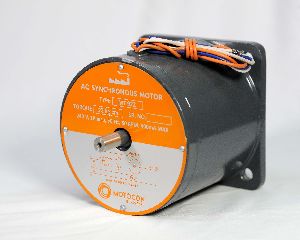
Synchrounous Motor
ApplicationOpen or Close Automobile Industries Paper Industries Automation Industries Pharmaceutical Industries Pharmaceutical equipment manufacturing Industries Food Processing Industries Printing Machines FeaturesOpen or Close Synchronous motors are inherently not self-starting. They require some external means to bring their speed close to synchronous speed to before they are synchronized. The speed of operation of is in synchronism with the supply frequency and hence for constant supply frequency they behave as constant speed motor irrespective of load condition This motor has the unique characteristics of operating under any electrical power factor. This makes it being used in electrical power factor improvement. Steps Angle 1.8 degree ± 0.1 Resistance ± 15% Induction ± 25% Temperature Rise-80degree C Maximum Insulation Resistance 100M min.-500VDC Die-Electric Strangth-2000VAC, 1min. Radial Play-.5mm ± 0.1 Axial Play-.5mm ± 0.
...more
Stepper Motor
applicationopen or close automobile industries paper industries automation industries pharmaceutical industries pharmaceutical equipment manufacturing industries food processing industries printing machines featuresopen or close they are considered constant power devices. when the motor speed of the stepper motor increases, the torque will decrease. often the most torque is exhibited when the motor is in a stationary state. the torque curve of the step motor can be extended by implementing a driver and increasing the driving voltage. these are known as chopper circuits and often driver chips can be found in many stores which makes the this process much simpler. stepper motors tend to be a bit more noisy compared to dc motors. when a step is made on the motor, the rotor will snap from one position to the next which makes the motor vibrate. at some speeds the vibrations can become so bad the motor may lose torque or direction. this happens because of the rotor which is being held in place by a magnetic field. each step the motor takes; the rotor overshoots and bounces back into place. this can cause the step motor to jump, changing its position and altering its direction. issue number 5 can be easily mitigated by simply accelerating quickly through the problem speeds range. another solution is to physically dampen the system. using a micro-stepping motor will also solve this issue. stepper motors that have a larger number of phases will have a smoother operation, much like micro-stepping motors. these devices are excellent in many applications, and their simplicity makes them very popular among hobbyists. some common uses forstepper motors include; slot machines, compact disc drives, computer printers, flatbed scanners, and so on. specificationsopen or close steps per revolution-200 steps angle 1.8 degree ± 0.1 resistance ± 15% induction ± 25% temperature rise-80degree c maximum insulation resistance 100m min.-500vdc die-electric strangth-1000vac, 1min. no. of leads-8 on request 4,6 radial play-.5mm ± 0.1 axial play-.5mm ± 0.1
Driven Type : Electric
...more
Induction Motor
Be first to Rate
Rate ThisOpening Hours